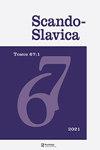Опыт прочтения повести А. С. Пушкина «Метель»: два да едино будет …
IF 0.2
0 HUMANITIES, MULTIDISCIPLINARY
引用次数: 0
Abstract
ABSTRACT The technique of close reading invites us to focus on particular points in the text that helps understand it as a work of art. In Puškin’s “Snowstorm” such points include the image of a snowstorm, literary clichés, paroemia like you cannot get around your intended on a horse (что суженого конем не объедешь), as well as several specific items, such as a Tula signet ring with a symbolic image of two burning hearts. And, strange as it may seem, the story’s happy ending is anticipated by “a suitable motto” casually mentioned in connection with the Tula signet ring – as a figure of silence without explanation in the text, but easily guessed by Puškin’s contemporaries as a motto accompanying the image of two burning hearts in the Dictionary of symbols and emblems (number 120), re-issued in St Petersburg in 1811. In this article, I offer a reading of the story as a rhetorical amplification of the “suitable motto” engraved on the Tula signet ring: Ut duo unum componant (‘That two may make but one’). I suggest to interpret this poetic design as a narrative program, incorporated into the text and structuring the narrative flow of the story.阅读A的经验C.国际合作普希金“暴风雪”:两个是一个。。。
摘要细读的技巧让我们关注文本中的特定点,这有助于将其理解为一件艺术作品。在普希金的《暴风雪》中,这些点包括暴风雪的图像、文学陈词滥调、戏仿,就像你骑着马无法绕过你想要的一样(часуженааралаканемниабедеша),以及一些特定的项目,比如一枚图拉印戒,上面有两颗燃烧的心的象征性图像。而且,尽管看起来很奇怪,故事的圆满结局是由“一句合适的座右铭”所预期的,这句格言与图拉图章戒指有关——在文本中是一个沉默的形象,没有任何解释,但普什金的同时代人很容易猜到,这句座右铭伴随着符号和徽章词典中两颗燃烧的心的图像(编号120),1811年在圣彼得堡重新发行。在这篇文章中,我对这个故事进行了解读,作为对图拉图章戒指上刻着的“合适的座右铭”的修辞放大:Ut duo unum compnant(“这两个可以造就一个”)。我建议将这种诗意的设计解读为一种叙事程序,融入文本并构建故事的叙事流程。
本文章由计算机程序翻译,如有差异,请以英文原文为准。
求助全文
约1分钟内获得全文
求助全文

 求助内容:
求助内容: 应助结果提醒方式:
应助结果提醒方式:


